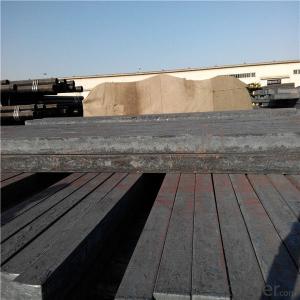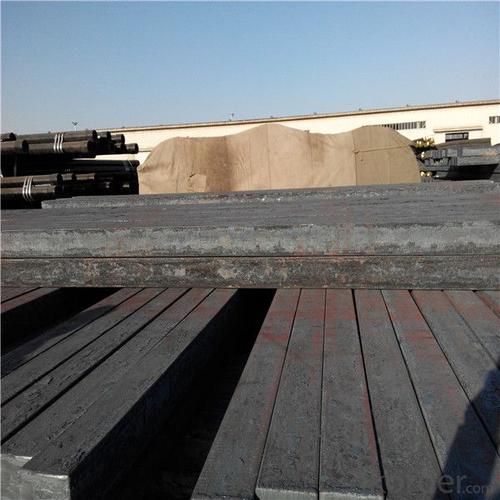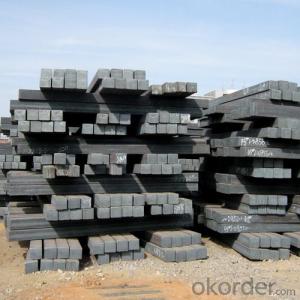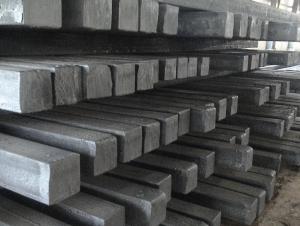Square Billets for steel products material
- Loading Port:
- China main port
- Payment Terms:
- TT OR LC
- Min Order Qty:
- 10000 m.t.
- Supply Capability:
- 14980 m.t./month
OKorder Service Pledge
OKorder Financial Service
You Might Also Like
Specification
Steel billet
(ingot) by cogging or breakdown of semifinished products, is the raw material of all kinds of steel mill.
Billet section of square, round, flat, rectangular and abnormity of several kinds of, mainly related to the
shape of rolled products.
Rectangular billet continuous casting billet and mainly general carbon steel, low carbon low silicon cold-rolled material, high quality carbon structural steel, high strength low alloy steel, special steel, etc.
The billet is mainly divided into two kinds from the shape:
Slab: cross section width and height of the ratio of the larger, mainly used for rolling plate.
Gade:
Standard | C(%) | Mn(%) | S(%) | P(%) | Si(%) |
Q195 | ≤0.12 | ≤0.50 | ≤0.040 | ≤0.035 | ≤0.30 |
Q235 | ≤0.20 | ≤1.40 | ≤0.045 | ≤0.045 | ≤0.35 |
Q275 | ≤0.22 | ≤1.50 | ≤0.045 | ≤0.045 | ≤0.35 |
20MnSi | 0.17-0.25 | 1.2-1.6 | ≤ 0.050 | ≤ 0.050 | 0.40-0.80 |
3SP | 0.14-0.22 | 0.40-0.85 | ≤ 0.050 | ≤ 0.040 | 0.05-0.15 |
5SP | 0.28-0.37 | 0.50-1.00 | ≤ 0.050 | ≤ 0.040 | 0.15-0.30 |
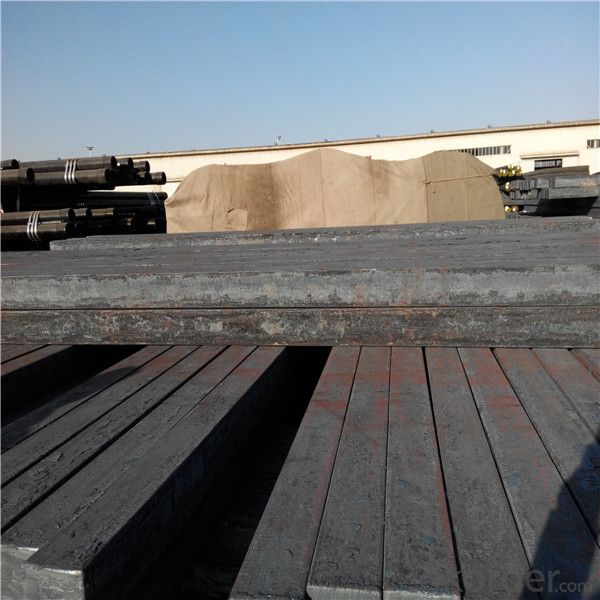
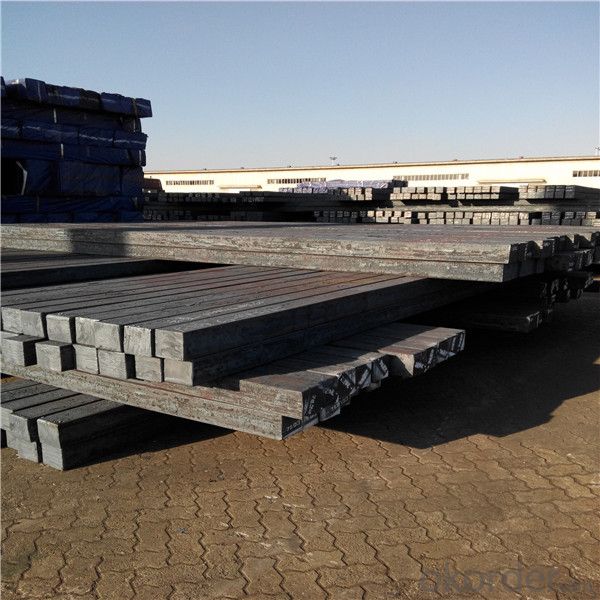
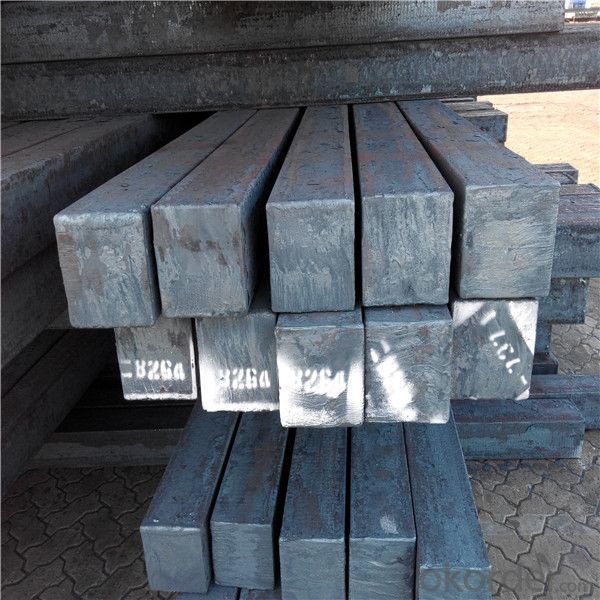

Our service :
We have a plant and professional team to provide our best service, from the start of production until the
loading into the vessel, we have a complete quality follow up procedure, to assure our products arrives to the customer with satisfaction. Welcome new and old customers
to contact us for future business relationships! We will give you a surpise price.
Packing :
Within 30 days
1.Standard export package
2.In bundles with steel strips
3.As the requirements of the customers
FAQ:
Q: What is payment terms?
A: FOB 30% T/T IN ADVANCE AS DEPOSIT AND 70% T/T BEFORE SHIPMENT
CIF and CFR 30% T/T IN ADVANCE AS DEPOSIT AND 70% T/T AS THE COPY OF B/L OR L/C AT SIGHT
Q:How to guarantee the quality of the products?
A:We have established the international advanced quality management system,every link from raw material
to final product we have strict quality test;We resolutely put an end to unqualified products flowing into the market.
At the same time, we will provide necessary follow-up service assurance.
Q:How long can we receive the product after purchase?
A :In the purchase of product within three working days, We will arrange the factory delivery as soon as possible.
The pecific time of receiving is related to the state and position of customers.
- Q: What is the standard tolerance for steel billet dimensions?
- The standard tolerance for steel billet dimensions can vary depending on the specific industry and application. However, commonly accepted tolerances for steel billet dimensions typically range from +/- 0.5% to +/- 2% of the specified dimensions.
- Q: How is the strength of steel billets measured?
- The strength of steel billets is typically measured using a tensile test, where a sample is subjected to pulling forces until it fractures. The maximum force applied during the test is recorded and used to determine the strength of the steel.
- Q: Are steel billets used in the manufacturing of tools?
- Yes, steel billets are commonly used in the manufacturing of tools. Steel billets serve as the starting material for various tool manufacturing processes, including forging, extrusion, and machining. These billets are typically heated and shaped into the desired tool form, which is then further processed and refined to create high-quality tools with excellent strength, durability, and performance.
- Q: How does the carbon content affect the properties of a steel billet?
- The properties of a steel billet are significantly impacted by its carbon content. Steel, which is primarily composed of iron and carbon, has its hardness, strength, and other mechanical properties determined by the amount of carbon present. Mild steel, also called low carbon steel, typically has a carbon content of less than 0.3%. It is known for being relatively soft, malleable, and easy to manipulate. This type of steel is commonly used in applications that require good formability, such as construction materials, automotive parts, and household appliances. Medium carbon steel, on the other hand, contains carbon ranging from 0.3% to 0.6%. This type of steel offers improved strength and hardness compared to low carbon steel. It is often utilized in applications that demand higher load-bearing capacity, like gears, shafts, and tools. High carbon steel, which contains more than 0.6% carbon, is renowned for its exceptional strength and hardness. It is commonly employed in applications that require high resistance to wear, such as cutting tools, springs, and high-strength wires. However, it is worth noting that high carbon steel tends to be more brittle and less ductile compared to low and medium carbon steels. Apart from its influence on mechanical properties, the carbon content also affects the steel's ability to undergo heat treatment. Low carbon steel cannot be hardened through heat treatment, whereas medium and high carbon steels can be heat treated to achieve the desired hardness and strength. Although other alloying elements like manganese, chromium, and nickel can be added to steel to further enhance its properties, the carbon content remains a critical factor in determining the overall performance of a steel billet.
- Q: What are the different joining methods used for steel billets?
- There are several different joining methods used for steel billets, depending on the specific application and desired outcome. Some of the most common joining methods include welding, brazing, and adhesive bonding. Welding is a widely used joining method for steel billets. It involves melting the edges of the billets and fusing them together, either with or without the use of a filler material. Welding can be done through various processes such as arc welding, resistance welding, or gas welding. It offers strong and durable joints, but the process can be complex and may require skilled operators. Brazing is another joining method used for steel billets. It involves heating the billets and melting a filler metal with a lower melting point, which is then allowed to flow between the joint surfaces and solidify. Brazing offers good strength and is often used for joining billets that are not easily weldable due to their composition or thickness. Adhesive bonding is a non-mechanical joining method that uses adhesives to bond the steel billets together. Adhesive bonding offers several advantages, including lightweight joints, uniform distribution of stress, and the ability to join dissimilar materials. It is also a versatile method that can accommodate various shapes and sizes of billets. However, adhesive bonding may not provide the same level of strength as welding or brazing, and it can be sensitive to environmental factors such as temperature and humidity. Other joining methods used for steel billets include mechanical fastening, such as bolting or riveting, and thermal joining methods like diffusion bonding or friction welding. Each joining method has its own advantages and limitations, and the choice of method depends on factors such as the specific application requirements, material properties, and cost considerations.
- Q: What is the role of steel billets in the manufacturing of tools and dies?
- Steel billets play a crucial role in the manufacturing of tools and dies as they serve as the raw material for shaping and forming these components. Billets are heated, forged, and machined to create the desired shape and strength required for tools and dies. The high-quality, durable nature of steel billets ensures that the resulting tools and dies possess the necessary hardness, toughness, and wear resistance to withstand the demanding conditions of their applications.
- Q: What are the factors that affect the mechanical properties of steel billets?
- The factors that affect the mechanical properties of steel billets include the chemical composition of the steel, the heat treatment process, the rolling and forging techniques used during manufacturing, and the presence of any impurities or defects in the billet. Additionally, the cooling rate after heat treatment and the grain size of the steel can also influence its mechanical properties.
- Q: How are steel billets used in the production of crankshafts?
- Steel billets are used in the production of crankshafts as they serve as the raw material that is shaped and machined to form the main body of the crankshaft. These billets are heated, forged, and then machined to create the precise shape and dimensions required for the crankshaft. This process ensures the strength, durability, and performance of the crankshaft in engines.
- Q: Are steel billets subject to any regulations or certifications?
- Steel billets must adhere to numerous regulations and certifications to guarantee their production, quality, and safety standards are met. The ISO 9001 certification, an internationally recognized standard for quality management systems, is one of the most common certifications for steel billets. This certification ensures that the manufacturing process of steel billets follows consistent quality control measures, from sourcing raw materials to final production. Steel billets may also need to obtain industry-specific certifications, depending on their intended use. For example, if the steel billets are intended for construction projects, they must comply with certifications such as ASTM standards or European EN standards. These certifications define the necessary mechanical properties, chemical composition, and other specifications that steel billets must meet to ensure they are suitable for construction purposes. In addition, governmental bodies or industry associations may impose regulations on steel billets. These regulations can include safety standards, environmental regulations, and compliance with trade policies. For instance, steel billet producers may need to comply with regulations regarding emissions, waste management, or occupational health and safety. In conclusion, various regulations and certifications are in place to ensure the quality, safety, and compliance with industry standards of steel billets. These certifications and regulations are crucial for maintaining the integrity of steel billets and ensuring they are suitable for various applications.
- Q: What are the advantages of using steel billets in construction?
- There are several advantages to using steel billets in construction. Firstly, steel billets are highly durable and have a high strength-to-weight ratio, making them ideal for withstanding heavy loads and structural demands. Additionally, steel billets can be easily molded and shaped into various forms, allowing for flexibility and customization in construction projects. Furthermore, steel billets are resistant to corrosion and can withstand harsh weather conditions, ensuring longevity and reduced maintenance costs. Lastly, steel billets are recyclable, making them an environmentally friendly choice for construction materials.
Send your message to us
Square Billets for steel products material
- Loading Port:
- China main port
- Payment Terms:
- TT OR LC
- Min Order Qty:
- 10000 m.t.
- Supply Capability:
- 14980 m.t./month
OKorder Service Pledge
OKorder Financial Service
Similar products
Hot products
Hot Searches
Related keywords
